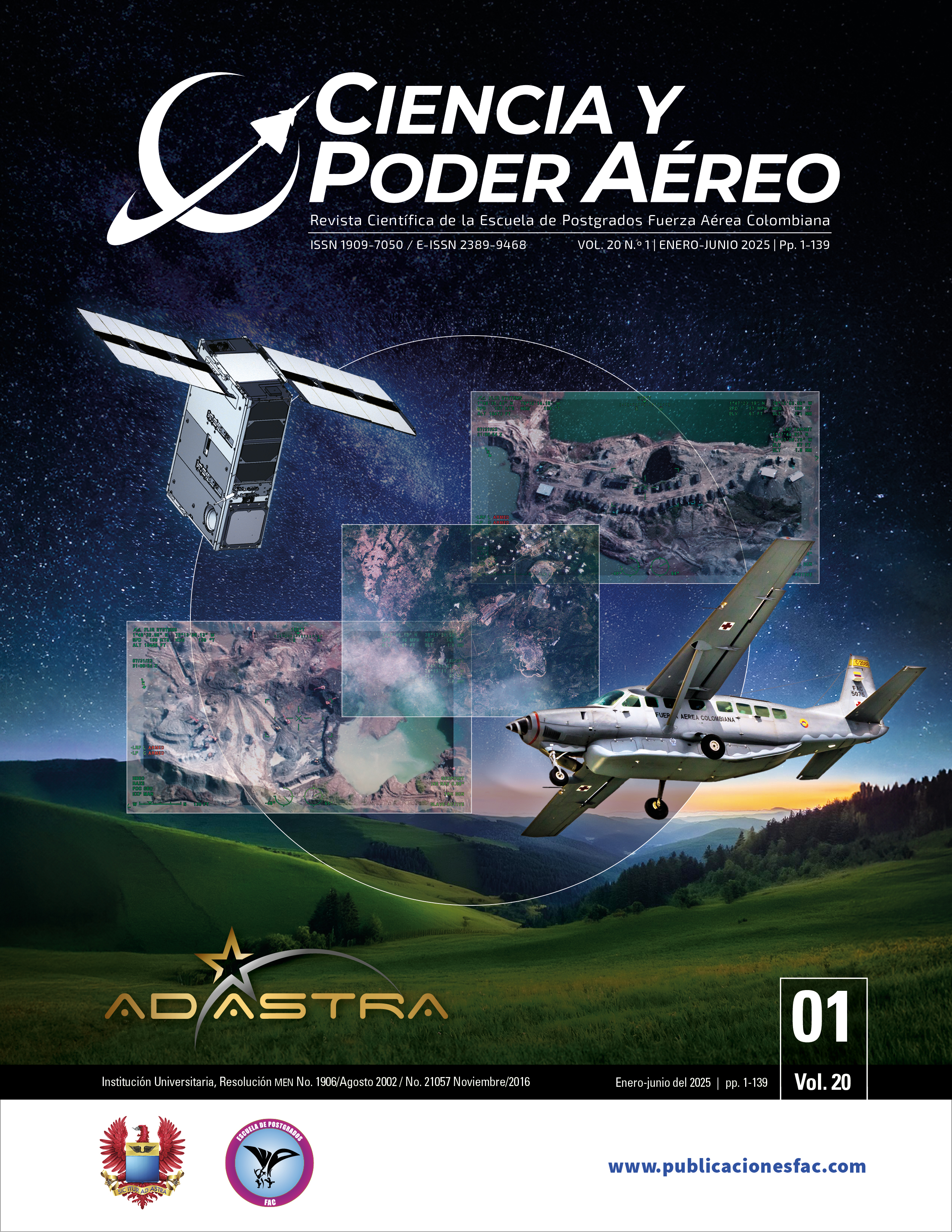Analysis of the Influenceof Adverse Weather onAircraft Operations
DOI:
https://doi.org/10.18667/cienciaypoderaereo.834Keywords:
Airport, delays, diversions, adverse weather, air operationsAbstract
The aviation industry is a vital component of global economic development, as it drives sectors such as tourism and trade. Adverse weather conditions significantly impact the safety and operational efficiency of aviation, which represents an important uncontrollable factor. This study aims to analyze the influence of adverse weather conditions on aviation operations. The findings show that 23 % of air accidents are related to meteorological factors such as adverse wind, low visibility, icing and turbulence. In addition, in the United States 82 % of flight delays and 42 % of flight cancellations are attributable to adverse weather events. The implementation of state-of-the-art technologies, such as artificial intelligence and predictive models, together with algorithms such as ATMAP (ATM Airport Performance), is considered crucial to improve planning and operational response to these conditions, enabling more efficient air traffic management, and maintaining the safety and punctuality of airport operations.
Downloads
References
Aerocivil. (2017). Anexo 01. Códigos de demora de causas de incumplimiento de itinerario. En: Circular informativa N.º 2. Metodología cálculo del cumplimiento aerocomercial de empresas de transporte aéreo regular de pasajeros [en línea]. https://www.aerocivil.gov.co/atencion/estadisticas-de-las-actividades-aeronauticas/Cumplimiento/Circular%20No.%202%20-Anexo.pdf
Bombelli, A. y Sallan, J. M. (2023). Analysis of the effect of extreme weather on the us domestic air network. A delay and cancellation propagation network approach. Journal of Transport Geography, 107. https://doi.org/10.1016/J.JTRANGEO.2023.103541 DOI: https://doi.org/10.1016/j.jtrangeo.2023.103541
CDETECH. (2024, 20 de mayo). Inteligencia artificial en la predicción del cambio climático [en línea]. https://cdetech.org/inteligencia-artificial-en-la-prediccion-del-cambioclimatico/#:~:text=Mejora%20de%20la%20Precisi%C3%B3n%20en%20las%20Predicciones%20Clim%C3%A1ticas&text=Por%20ejemplo%2C%20algoritmos%20de%20IA,olas%20de%20calor%20y%20sequ%C3%ADas
Goodman, C. J. y Small-Griswold, J. D. (2019). Meteorological impacts on commercial aviation delays and cancellations in the continental United States. Journal of Applied Meteorology and Climatology, 58(3), 479-494. https://doi.org/10.1175/JAMC-D-17-0277.1 DOI: https://doi.org/10.1175/JAMC-D-17-0277.1
Gultepe, I. (2023). A review on weather impact on aviation operations: Visibility, wind, precipitation, icing. Journal of Airline Operations and Aviation Management, 2(1), 1-44. https://doi.org/10.56801/JAOAM.V2I1.1 DOI: https://doi.org/10.56801/jaoam.v2i1.1
Gultepe, I., Sharman, R., Williams, P. D., Zhou, B., Ellrod, G., Minnis, P., Trier, S., Griffin, S., Yum, S. S., Gharabaghi, B., Feltz, W., Temimi, M., Pu, Z., Storer, L. N., Kneringer, P., Weston, M. J., Chuang, H. ya, Thobois, L., Dimri, A. P., … Albquerque Neto, F. L. (2019). A review of high impact weather for aviation meteorology. Pure and Applied Geophysics, 176, 1869-1921. https://doi.org/10.1007/s00024-019-02168-6 DOI: https://doi.org/10.1007/s00024-019-02168-6
Hamlet. (2021, 19 de mayo). Un nuevo algoritmo permite predecir la formación de tormentas en el aeropuerto de Madrid- Barajas [en línea]. https://www.uco.es/hamlet/index.php/noticias/13-un-nuevo-algoritmo-permitepredecir-la-formacion-de-tormentas-en-el-aeropuertode-madrid-barajas
Hartigan, J. A. y M. A. Wong. (1979). Algorithm AS 136: A K-Means Clustering Algorithm. Journal of the Royal Statistical Society. Series C (Applied Statistics), 28(1), 100- 108. https://www.stat.cmu.edu/~rnugent/PCMI2016/papers/HartiganKMeans.pdf DOI: https://doi.org/10.2307/2346830
Hosteltur España. (2008, 13 de noviembre). Identifican las cinco causas fundamentales de los retrasos aéreos [en línea]. https://www.hosteltur.com/57156_identifican-cinco-causas-fundamentales-retrasos-aereos.html
Oo, K. T. y Oo, K. L. (2022). Analysis of the most common aviation weather hazard and its key mechanisms over the Yangon flight information region. Advances in Meteorology [en línea]. https://doi.org/10.1155/2022/5356563 DOI: https://doi.org/10.1155/2022/5356563
Peñas-Pérez, I. (2022). Predicción de trayectorias de aeronaves empleando algoritmos de Deep Learning [trabajo de grado, Universidad de Valladolid]. Repositorio institucional UVa. https://uvadoc.uva.es/handle/10324/55658
Rairán, S. (2023, 20 de noviembre). Aeropuerto El Dorado anuncia demoras en vuelos: estas serían las causas. Infobae [en línea]. https://www.infobae.com/colombia/2023/11/21/aeropuerto-el-dorado-anuncia-demoras-envuelos-estas-serian-las-causas/
Rodríguez-Sanz, Á., Cano, J. y Rubio-Fernández, B. (2021). Impact of weather conditions on airport arrival delay and throughput. IOP Conference Series: Materials Science and Engineering, 1024(1). https://doi.org/10.1088/1757-899X/1024/1/012107 DOI: https://doi.org/10.1088/1757-899X/1024/1/012107
Schultz, M., Lorenz, S., Schmitz, R. y Delgado, L. (2018). Weather impact on airport performance. Aerospace, 5(4). https://doi.org/10.3390/aerospace5040109 DOI: https://doi.org/10.3390/aerospace5040109
Schultz, M., Reitmann, S. y Alam, S. (2019). Classification of weather impacts on airport operations. 2019 Winter Simulation Conference (wsc). Diciembre 8-11 de 2018. https://doi.org/10.1109/WSC40007.2019.9004915 DOI: https://doi.org/10.1109/WSC40007.2019.9004915
Valenciano, J. R. (2023, 1 de octubre). Aplicación de la inteligencia artificial al pronóstico de las variables meteorológicas en el aeropuerto de Vigo. aemet Blog [en línea]. https://aemetblog.es/2023/10/01/aplicacion-de-lainteligencia-artificial-al-pronostico-de-las-variablesmeteorologicas- en-el-aeropuerto-de-vigo/
Wallace, G. y Rothenberg, E. (2023, 7 de agosto). Miles de vuelos cancelados y retrasados en ee .uu. por el mal tiempo que amenaza el este del país. CNN en Español [en línea]. https://cnnespanol.cnn.com/2023/08/07/milesvuelosretrasados-mal-tiempo-este-eeuu-trax
Downloads
Published
Issue
Section
License
Copyright (c) 2024 Escuela de Postgrados de la Fuerza Aérea Colombiana

This work is licensed under a Creative Commons Attribution 4.0 International License.
Assignment of Copyrights
Authors assign Ciencia y Poder Aéreo journal the exclusive rights (reproduction, distribution, public communication, and transformation) to exploit and commercialize their work, in whole or in part, in all the formats and modalities of present or future exploitation, in all languages, throughout the life of the work and throughout the world.
All contents published in Ciencia y Poder Aéreo journal are licensed under a Creative Commons Attribution 4.0 International License, whose complete information is available at http://creativecommons.org/licenses/by/4.0/
Under the terms of this license, users are free to download, print, extract, archive, distribute and publicly communicate the content of articles, provided that proper credit is granted to authors and Ciencia y Poder Aéreo, scientific journal of the Graduate School of the Colombian Air Force. Except when otherwise indicated, this site and its contents are licensed under a Creative Commons Attribution 4.0 International License.
For other uses not considered under this license it is required to contact the Director or the Editor of the journal at the e-mail address cienciaypoderaereo1@gmail.com.
The Graduate School of the Colombian Air Force and this publication are not responsible for the concepts expressed in the articles, including the metadata or the affiliation stated by authors. This is the full responsibility of the authors.






















